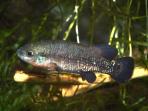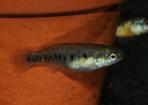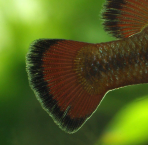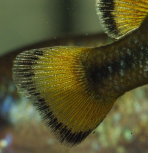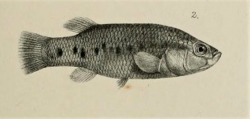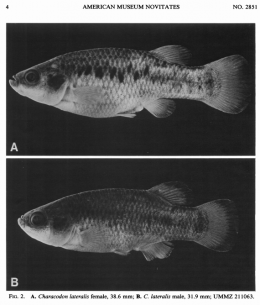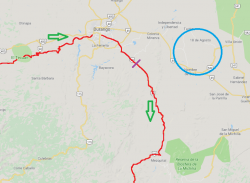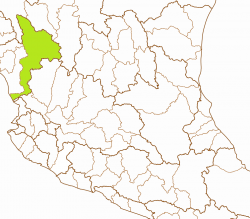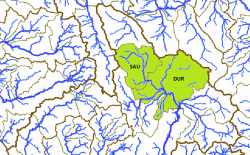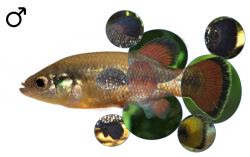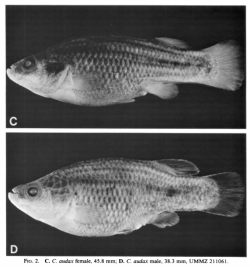- HOME
- WHO WE ARE
- NEWS AND DATES
- GOODEIDS
- PHYLOGENY
- ARTIFICIAL KEY
- GOODEID SPECIES
- BIOLOGY
- ENVIRONMENT
- CONSERVATION
- PROFUNDULIDS
- MEMBERS AREA
Characodon lateralis
English Name:
Bold Characodon, the dark finned form Black Prince
Mexican Name:
Mexclapique del Toboso
Original Description:
GÜNTHER, A. (1866): Catalogue of the Physostomini. Catalogue of Fishes of the British Museum 6: pp 1-368
Holotype:
Collection-number: British Museum of Natural History, Cat. No. BMNH-1855-9-19.
Albert Günther didn't designate a Holotype. The types are nine specimens collected by Berthold Carl Seemann, concerning type locality and date of collection, see the following chapter.
The left picture show a drawing of one of the types of Characodon lateralis, the right one two specimens Miller used in his description of Characodon audax (now a synonym of Ch. lateralis) for comparison:
Terra typica:
Following Günther, the types come from "Central America", but this is definitely not precise enough, as he mentioned, that four of the fish he got for the British Museum, were part of B. C. Seemanns collection, whereas five more came from a collection of the Haslar Hospital Museum, but originated in the same collection of Seemann (J. Richardson, 1852). Seemann, who was botanist and appointed naturalist on a voyage of the HMS Herald from 1847-51, undertook a road trip during this journey from Mazatlán to Durango (23.11.1849-02.01.1850). That day in January he left the city of Durango and went southwards, reaching the town of Mezquital three days later on January the 5th. In this three days' period he most likely collected the types of Characodon lateralis.
Here a few sentences out of his narrative about the whole voyage, concerning his road trip from Durango to Mezquital (Narrative of the voyage of H.M.S. Herald during the years 1845-51, under the command of Captain Henry Kellett... being a circumnavigation of the globe, and three cruizes to the Arctic regions in search of Sir John Franklin, B. C. Seemann, about Durango: pp: 159-174): "My original plan was to visit Chihuahua. The principal reason which induced me to alter the route was the season. [...] I therefore took a south-western direction, the road to Tepic. Departing from Durango on the 2nd of January, 1850. I reached on the 5th instant, Mesquital, a considerable village, [...]. I collected however a good many specimens, the vegetation not having suffered so much from frost as in that part of the Sierra Madre which I crossed when coming from Mazatlan."
The left picture shows the probable travel route of Seemann to and from Durango city, the right picture the Cascada el Saltito, the waterfalls separating the habitats of Characodon lateralis above the fall from those of the two Characodon species below the fall. Seemann was a very sharp observer and accurate describer of what he saw. It is hard to believe that he took a way that brought him to the waterfall and further on the habitats of the Rainbow Goodeid (Characodon sp. 1) without even mentioning this impressive natural wonder. The only explanation is that he indeed took the road shown on the left map. This is the most important argument in synonymzing Characodon audax with lateralis. Explaining the following map: the red line is the road Seemann used, the green arrows show the ways he came to and left from the city of Durango. Again, it meets the Arroyo La Estancia next to Pino Suarez (violet bar), a creek which is inhabited by a population of Characodon, we labeled as audax before, so the conclusion out of that is that the type location of Characodon lateralis is most likely this creek, or another one close by, that the group with Seemann crossed before.
Etymology:
The species name is derived from the Latin with the word "latus" meaning side and "lateralis" meaning located on the side. The epithet refers to the lateral stripe in the colour pattern of this fish, mainly visible in preservation.
The genus was erected by Günther in 1866. He didn't explain why he had chosen this name, but it is obvioulsy refering to the typical dentition. The name of the genus can be derived from the ancient Greek with Χάραξ (chárax), meaning "a pointed stake" and ὀδόντος (ódóntos), the genitive of ὁδούς (ódoús), the tooth. So the name of the genus can be translated with "a tooth like a pointed stake".
Synonyms:
Characodon sp. Radda, 1984
Characodon audax Smith & Miller, 1986
Distribution and ESU's:
The Bold Characodon is endemic to the Mexican federal state of Durango. It historically occured in springs and creeks along the Río La Sauceda, the name of the headwaters of the Río Mezquital, and the subsequent section of this river named Río El Tunal above the Saltito Falls (Cascada El Saltito) about 10km NNW of the town Nombre de Díos. The northernmost known habitat is the Arroyo Los Mimbres at Los Pinos, the southernmost the Arroyo La Estancia at Pino Suarez. Between these two creeks, the species is known from several creeks and springs like the Laguna Seca area E of the Arroyo Acequia Vieja, a main tributary of the Río Sauceda, and the manantiales Los Mujeres near El Toboso and El Garabato. The species disappeared from part of its original range and can't be found anymore in the Arroyo Los Mimbres and in springs near Cerro Gordo and San Vicente de los Chupaderos. It was also extirpated from spring habitats around Victoria de Durango that were originally inhabitated by this species. It still can be found in small to very small numbers in the Laguna Seca area, springs near El Toboso and Abraham Gonzales, the El Garabato spring area, the arroyos Las Moras and La Estancia and several springs W of the Río Sauceda between El Canatlán and the Presa Peña del Aguila. Taking in consideration its affiliation to different isolated springs and creeks, seven subpopulations can be distinguished: The El Toboso subpopulation, the Los Pinos subpopulation, the Laguna Seca subpopulation, the El Garabato subpopulation, the Río La Sauceda subpopulation, the Pino Suarez subpopulation and the Victoria de Durango subpopulation. The last one is regarded Extinct. The bold names are the ones officially used by the Instituto Nacional de Estadística y Geografía; nevertheless, other ones might be more often in use or better known and therefore prefered.
ESU ist short for Evolutionarily Significant Unit. Each unit expresses an isolated population with different genetic characteristics within one species. ESU's can be defined by Molecular genetics, Morphology and/or Zoogeography and help in indicating different phylogenetic lineages within a species. The abbreviation for an ESU is composed of three letters of the genus, followed by the first two letters of the species name and an ongoing number in each species.
Within Characodon lateralis we distinguish - with some uncertainties - seven different ESU's. We use the ESU abbrevaitions given by John Lyons, who groups all Characodon for now as Characodon sp.
Chrsp1 is restricted to the Ojo de Agua de las Mujéres spring, its ourflow and the dammed lagoon at the tiny village of El Toboso, the Black Prince, how it is called. This is the only population we know (mostly) without red colour in captivity. However, wild fish show red fins, too. Chrsp2 summarizes the populations on the west bank of the Río Tunal, north of the Presa Peña de Aguila up to approximately San José de Gracia south of El Canatlán. We do honestly not know how far north or south we can find this ESU. It included (maybe) the extinct population at Cerro Gordo on the east bank of the Río Tunal, but there is no possibility left to figure this out. Chrsp3 encompasses the fish from the vicinity of El Canatlán which is named Los Pinos by aquarists. It is definitly different from fish of the east bank of the Río Tunal in its vicinity (Laguna Seca east of Guadalupe Aguilera), but we cannot say if there isnt a gradient from the former ESU leading to this one. This needs forther studies. Chrsp4 is used for populations on the east bank of the Río Tunal in the triangle between Guadalupe Aguilera, Venustiano Carranza and Colónia Anohuác, namely the Laguna Seca spring and some others in its vicinity. Chrsp5 is a very uncertain ESU. It encompasses from the north the spring at San Vicente de los Chupaderos to habitats south of Victoria de Durango. There are no living populations known, so there is little chance to figure out relationships. In contrary to the former ESU, the next on, Chrsp6 is clear. Fish from the spring area north of 27. de Noviembre called Ojo Garabato and the spring at Abraham Gonzales, but maybe also springs south of 27. de Noviembre belong to this ESU. The only known population far south of Victoria de Durango in the Arroyo La Estancia at Pino Suarez, an affluent of the Río Mezquital, forms up the last nown ESU, Chrsp7.
The left map shows the Río San Pedro basin from the Hydrographic Region Presidio-San Pedro on a Mexico map. The Bold Characodon is known from the ríos Sauceda (SAU) and Durango (DUR) subbasins, both Río San Pedro basin and shown on the right map. In case of Characodon lateralis the different subbasins do not separate different ESU's as they are actually accepted: While Chrsp1 (El Toboso), Chrsp6 (Ojo Garabato/Abraham Gonzales) and Chrsp7 (Pino Suarez) are known from the Río Durango subbasin, the ESU's Chrsp2 (Río La Sauceda west bank), Chrsp3 (El Canatlan) and Chrsp4 (Laguna Seca) are located in the Río Sauceda subbasin. In case of Chrsp5 from the vicinity of the city of Durango, the spring near San Vicente de los Chupaderos is located in the upper drainage of the river, the former habitats south and east of Durango to the lower, so this ESU is actually split by the subbasin line. However, further studies will give us a better understanding in the future. Chrsp3 and Chrsp5 are regarded Extinct, respectively Extinct in the Wild:
Status :
International Union for Conservation of Nature (IUCN): Endangered
Distribution and current conservation status of the Mexican Goodeidae (Lyons et al., 2019): Critically Endangered/declining: „The taxonomy and relationships of the Characodon populations occupying the upper Tunal and Durango river drainages in the upper Mezquital River basin in the state of Durango are currently unresolved. Originally, a single species, C. lateralis, was recognized, which occupied a series of semi-isolated spring systems near the city of Durango. However, the locality given for the original collection of the species, “Central America”, was clearly erroneous and the type material could not be attributed to a specific spring system (Miller et al., 2005). In the 1980’s, the population in the springs near the town of El Toboso was described as a separate species, C. audax, based on morphology, with the remaining populations considered C. lateralis (Smith and Miller, 1986). However, more recent genetic analyses revealed little difference between the El Toboso population and other nearby Characodon populations (Doadrio and Domínguez-Domínguez, 2004; Domínguez-Domínguez et al., 2006). Instead, these analyses indicated that populations from spring systems located above the El Salto Waterfall on the Tunal River differed from those located below the falls, suggesting that perhaps all populations above the falls could be called C. audax and those below the falls C. lateralis. However, Artigas-Azas (2014) provided strong circumstantial evidence that the type of C. lateralis probably came from somewhere near the city of Durango above the falls, making it an inappropriate name for populations below the falls. Recent morphological analyses have indicated significant differences among ten populations, nine from above the falls and one from below, with the El Toboso population the most distinctive (Tobler and Bertrand, 2014). Given uncertainly about which populations the name C. lateralis actually refers to and the discordance between the morphological and the genetic distinctiveness of the nominal C. audax from the El Toboso Springs, we have chosen to refer to all populations from the Tunal and Durango River drainages as “Characodon species”, pending a comprehensive revision of the genus. We have also identified nine ESUs, seven from above the falls and two from below, based on a combination of genetic, morphological, and zoogeographic information. Regardless of what their taxonomic affinities are, all of the Characodon species ESUs are in serious trouble. Three ESUs have gone extinct in the last 20 years and the remaining six have all suffered steep drops in abundance (Artigas-Azas 2002, 2014). Declines have been caused by the drying of springs and streams owing to groundwater pumping and water diversions and by the introductions of non-native fish species. Chrsp1, the nominal C. audax from the El Toboso Springs, is critically endangered. Chrsp2, from the Cerro Gordo and El Carmen Springs and from the San Rafael and Las Moras streams, is also critically endangered and persists in small numbers only in the El Carmen Springs and in the Las Moras Stream in the town of San Rafael. Chrsp3, from the Los Pinos Springs and outlet, is extinct in the wild, with the last specimens collected in the late 1990’s. There are a few captive populations in Mexico, the United States, and Europe. Chrsp4, from the Guadalupe Aguilera, Laguna Seca, and Aguada de las Mujeres Springs and the Peñon del Aquila Reservoir, is critically endangered and current exists only in the Guadalupe Aguilera Springs. Chrsp5, from the San Vicente de los Chupaderos Springs and the Sauceda River, is extinct with no captive populations. The last collections date from the early 1990’s. Chrsp6, from the Abraham Gonzáles, Ojo Garabato, and 27 de Noviembre springs, is critically endangered but is still found in small numbers in all three springs. Chrsp7, from the Puente Pino Suárez Stream, is also critically endangered. Chrsp8, known from the Ojo de Aqua de San Juan, Los Berros, Ojo Nombre de Dios, and La Constancia springs, all located below the El Salto waterfall, is critically endangered and has disappeared from the Ojo Nombre de Dios Springs. Chrsp9, from the Amado Nervo Stream, also located below the El Salto Waterfall is probably extinct in the wild, with the last specimens observed in 2005. A small number of captive populations exists in Mexico, the United States, and Europe.“
NOM-059-SEMARNAT-2010: Categoría de riesgo (Category of risk): P - En Peligro de Extinción (in danger of extinction)
Habitat:
The habitats of Characodon lateralis are mostly spring-fed ponds and small creeks with currents slight to none and substrates made of sand, gravel and deep silty mud. The species prefers depths from 0.2 to 0.5m. The vegetation in the habitats comprises mainly green algae, Duckweed (Lemna), Pondweed (Potamogeton) and Nymphaea.
On a survey of the GWG in January 2015 to Durango, the group found this species in several, partly completely diverging habitats. Within the area of the Laguna Seca, they were able to find this species in several springs, all of them with substrates of sand and mud, segmented with big rocks and without plants except for a short aufwuchs on the rocks. All of these biotops were sinks with several springs coming out of the ground, oxgen level around 10mg/l with clear or murky water by activity of Tilapias, that were present in most of the springs. Some of these springs were very small and the populations in danger to become extinct. In Abraham Gonzales, the group was not able to find Characodon in the main spring which is inhabited by predatory Micropterus, but found them at one place over flooded lawn, water depth less than 20cm and full with decomposing grass and organic matter. In El Toboso, the Ojo de las Mujeres spring was superficially dry, but water came trough the ground next to it. The outflow was occupied by Gambusia senilis and didnt reveal any Characodon. They were able to find them in the subsequent lagoons, where the water temperature was lower than in the outflow (around 19°C) over substrates of mud and sand and loose stocks of Potamogeton. They were able to find this species in the spring area of 27. de Noviembre called Ojo Garabato in clear mud dark and brown water. The only plants were riperian grass and reed, giving shelter to the fish from predatory Micropterus and Lepomis. The water temperature ranged from 17 to 21°C. The group couldnt find this species in the outflow of the spring area near 27. de Noviembre, maybe because of cold water, but this may be doubtful as they were able to find fully active fish in the Arroyo La Estancia near Pino Suaréz at 8.7°C. This habitat was at that time a sandy and slow flowing creek fragmented in several pools that partly become dry over the summer period. West of the Río Tunal, they saw this species in a spring on a private property in milky water in dense vegetation, depth approximately 1.5m, and in the Arroyo Las Moras in San Rafael. The water showed no hardness at all probably because of the washing of laundry. Garbage was everywhere and the fish were hiding in dense vegetation, probably a Ludwigia species. The creek was swift flowing and had a depth of about 30cm. The habitats at Los Pinos (a shallow very slow floating creek occupied by green algae) and San Vicente de los Chupaderos (a spring pool with reed over mud, occupied with predatory Procambarus clarkii and Lepomis) didn't reveal any Characodon. The spring at Cerro Gordo was dry as expected.
Biology:
When Smith and Miller collected the species of Characodon audax (now C. lateralis) on March the 16th in 1982, they found no young fish, but the ovaries of females were containing embryos.
Diet:
Characodon lateralis has got bicuspid teeth in the outer series (a few smaller ones are conical) of adult fish, and small conical in the inner series. This dentition suggests an omnivorous feeding habit, but young fish have only conical teeth, so they are definitely carnivorous. The gut of this species is short, so it seems to feed mainly carnivorous with some plasticity concerning nutriment, which would explain observations of people seeing this fish feeding from aufwuchs and filamentous algae in the habitat. A radiograph of an adult specimen by Michael Tobler shows a couple of small snailshells in its viscera.
Size:
The maximum known standard length is about 48mm (Miller et al., 2005).
Colouration:
The Bold Characodon is olivaceous-greyish to light brown coloured. Females have additionally a regular or irregular serious of a varying number of black lateral blotches while only few males show some in the anterior part of the body. The fins of females are clear to light yellowish with a sometimes grey terminal band in unpaired fins, while males usually display a crimson to dark red (in rare cases light orange or yellow) in its unpaired fins. All of these fins have additionally a more or less broad black terminal band, in the case of the population from El Toboso, the black overlays the red sometimes completely. The red of the fins extends in dominant males into the posterior part of the body and colours the fish in rare cases totally red. Again, the form from El Toboso is an exception with only little red on the body that disappears mostly after a few days in the aquarium (food induced?). These fish appear then silvery grey with shiny scales on the sides and black unpaired fins and a sometimes black posterior part of the body. The ventral part of all males can display yellow to salmon red when the fish is dominant and fed with food containing carotenes.
Sexual Dimorphism:
Males and females of the Bold Characodon are easy to distinguish. A safe characteristic is the Splitfin in males, means the for Goodeinae typical mating organ formed by a notch after the first seven shortened rays of the Anal fin. Additionally, male Characodon lateralis have a slightly bigger Dorsal fin than females. The difference in colouration is clear and very distinct. Males have its unpaired fins coloured intensely red (crimson to dark), rarely orange to yellow, or totally black. In dominant males, the colour will extent onto the (at least) posterior part of the body. The unpaired fins display a more or less broad black terminal band. Some black lateral blotches may be seen on the anterior part of the body only in a few specimens. Females are tonelessly brownish-greyish coloured with clear to slightly yellowish unpaired fins, sometimes framed by a grey terminal band. They (usually) display a regular or irregular serious of black lateral blotches.
Remarks:
In all Characodon species we find different varieties of colouration of males in one population. Usually red finned males are most frequent, but (maybe even changing by year) other varieties might take over this role. While a German surveyor found in Los Berros (Characodon sp. 1) red bellied males dominating in 2005, the GWG group surveying the same habitat ten years later didn't find any male with red. All males had a typical female colour pattern. It is known from Characodon sp. 2 from Amado Nervo, that usually males with clear unpaired fins occured in the wild, but few males displayed a reddish or yellowish colour. Different populations from Characodon lateralis showed up male fins from clear to reddish, crimson red, dark red and sometimes even totally red body, and even the black of fish from El Toboso varies, so males can appear with red unpaired fins and less broad black terminal band. In aquariums, usually red finned males (or totally black finned from El Toboso) dominate and this colour gets more intense, so less coloured male types slowly disappear.
Albert Günther described this species from specimens, the British Museum obtained from Berthold Carl Seemann (see chapter Terra typica). He labeled them with the collection info "Central America" and he himself (1869) complained about the inadequacy of the locality information of Seemann's collection. J. M. Fitzsimons (1972) was sure, that this imprecise given locality finally led - in his eyes - unnecessary description of Characodon garmani from Parras by Jordan & Evermann in 1898, and again by Meek in 1904 for specimens from Durango.
All Characodon (except most of the time the one known female of C. garmani) were called Characodon lateralis until the middle of the 1980's, suggesting that the unknown type locality was eventually close to Los Berros. In 1986 then, Smith & Miller described Characodon audax from the vicinity of El Toboso. The specimens from this location display black coloured unpaired fins, and this together with its isoltaed occurence was seen as the main character to distinguish this species from the red finned Characodon lateralis. In the early years of this Millenium, phylogenetic studies of Domínguez-Domínguez however revealed, that all red finned populations north of the waterfalls of El Saltito were closer related with the black audax from El Toboso than with the red finned populations south of the El Saltito fall. This resulted in calling the populations above the fall Characodon audax and the ones below the fall Characodon lateralis. The last study by Sherman et al. suggested to accept that the type locality of Characodon lateralis is somewhere close to Durango and to call therefore all specimens above the Saltito fall Characodon lateralis, which resulted in synonymizing Characodon audax with Characodon lateralis, but made it necessary to describe the species below the waterfalls, now two and called Characodon sp. 1 from Los Berros and Characodon sp. 2 from Amado Nervo.
The type location of Characodon audax is a spring-fed pond called El Ojo de Agua de Las Mujéres, near the village of El Toboso, 10.4km N of HW 40 in the state of Durango. The left picture shows photos of Paratypes of both sexes from the Millers description, the right one the type locality in the middle of the 1990's, photo taken by Ivan Dibble:
Some thoughts from James Langhammer to the historic situation of the Río Mezquital and the Characodon spp.: "The waters above the Falls can still today all be connected to one another during heavy raining seasons - and historically made a continuum northward to the basin that housed Characodon garmani. The historical distribution was a continuous channel that probably flowed year-round. The headwaters originated near the Los Pinos home range, flowed down to Guadalupe Aguilera and Los Chupaderos, then to the location where presently the High Falls pirated the system onto the Mezquital. Prior to the piracy the system turned northward and flowed to the confluence where El Toboso, Abraham Gonzales and 27 de Noviembre join it, and then flowed north to the presumed habitat of Characodon garmani and then merged with the boundary river (Río Grande del Norte) between the USA and México. This is fully documented in a hard-to-find paper on the distribution of Garter Snakes."
Husbandry:
Looking on the biotopes of Characodon lateralis, they suggest the species may prefer a habitat with moderate to swift current, structured with gravel, rocks, roots, branches, fallen leaves and river bank vegetation. Fry is eaten in some cases, but it may depend on the quantity and quality of food and on the number of places to hide. When several different stages of juveniles occur, fry may be neglected, so it makes sense to add separate brought up fry to the group with a size of 1.5 or 2cm to provide these stages and get a flock breeding colony.
The recommended tank size is at least 150 liters, bigger tanks with a generous base and little height (25cm are enough) are better for sure. With rocks and vegetation in the corners and backside of the tank well structured tanks combined with some roots and/or wood seem to do best with this species. The current should be moderate or swift, especially as the species is adapted to a high oxygene level (at least 8mg/l).
In the wild, the species feeds mainly from small or middle-sized invertebrates like bloodworms or insect larvae, so feeding with similar food, water fleas, Mysids and other food from animalistic sources will be best for this predatory fish. In aquarium, it feeds also well from flake food, granulate and even tablets, additionally given Nauplia of Brine Shrimps are eaten greedy. Additionally, aufwuchs and green algae may be taken in the natural habitat, so providing some kind of vegetables like boiled peas is a good food supplement. The species is not shy.
Concerning water quality, this species is in need of bigger water changes (60-80% every week) like most of the Goodeids, especially river and spring inhabiting species, so an automatic water changing system can be helpful. Otherwise, in combination with constant temperatures higher than 24°C, fish may get sick, lose resistance against diseases and age too fast. So for keeping the strain healthy and strong, give the fish a rest during winter time with temperatures lower than 20°C for 2 or 3 months so they stop producing fry. In spring, when the temperature slowly increases, they will start spawning at 20 or 21°C and won't stop until it gets colder again or when it gets too warm (25°C).
This species is doing very well when is kept in the open from spring to fall, starting when the water temperature by day exceeds 17°C and cold periods are no longer expected. Bring them out in the early afternoon, the time of the day with the highest water temperature. During the warm summer, reproduction will stop and may occur again in fall. Bring the fish in before the water temperature deceeds 17°C by day and keep them cool for the first days, then slowly raise the temperature but try to stay below 20°C over the winter time.
Populations in holding:
Here each species are assigned populations of fish in husbandry and in brackets aliases of these locations to assist in identifying own stocks. Each population is assigned a unique Population-ID, composed by the ESU, the subbasin where this population is occurring (three capital letters) and a unique location identifier.
Populations in holding:
1. Chrsp1-DUR-ETob
Population: El Toboso (aka Manantial el Ojo de Agua de las Mujeres)
Hydrographic region: Presidio-San Pedro
Basin: Río San Pedro
Subbasin: Río Durango
Locality: Outflow of the spring and subsequent dammed areas near the village of El Toboso
2. Chrsp2-SAU-ECar
Population: El Carmén
Hydrographic region: Presidio-San Pedro
Basin: Río San Pedro
Subbasin: Río Sauceda
Locality: Spring on a private property in El Carmén, about 4.5km N of la Joya
3. Chrsp2-SAU-SRaf
Population: San Rafaél (aka Río Las Moras)
Hydrographic region: Presidio-San Pedro
Basin: Río San Pedro
Subbasin: Río Sauceda
Locality: Río Las Moras at San Rafaél
4. Chrsp3-SAU-LPin2
Population: Los Pinos (aka El Canatlán, Los Pinos II)
Hydrographic region: Presidio-San Pedro
Basin: Río San Pedro
Subbasin: Río Sauceda
Locality:
5. Chrsp4-SAU-LSec
Population: Laguna Seca (aka Laguna Seca 1 to 5, Guadalupe Aguilera, Citlalli spring, Anahuac)
Hydrographic region: Presidio-San Pedro
Basin: Río San Pedro
Subbasin: Río Sauceda
Localities: Laguna Seca, five (partially) separate springs: main spring (LS1), spring 50m N (LS2), spring 400m S (LS3), spring 500m NE (Citlalli spring, LS4) and spring 1.7km SE (Anahuac, LS5) of main spring
6. Chrsp6-DUR-AGonz
Population: Abraham Gonzales
Hydrographic region: Presidio-San Pedro
Basin: Río San Pedro
Subbasin: Río Durango
Locality: spring system N and E of Abraham Gonzales
7. Chrsp6-DUR-OGar
Population: Ojo Garabato (aka 27. de Noviembre, Veintisiete de Noviembre)
Hydrographic region: Presidio-San Pedro
Basin: Río San Pedro
Subbasin: Río Durango
Locality: Ojo Garabato spring system N of 27. de Noviembre
8. Chrsp7-DUR-PSua
Population: Pino Suarez (aka Puente Pino Suarez)
Hydrographic region: Presidio-San Pedro
Basin: Río San Pedro
Subbasin: Río Durango
Locality: Arroyo La Estancia at the bridge (Puente) at Pino Suarez



